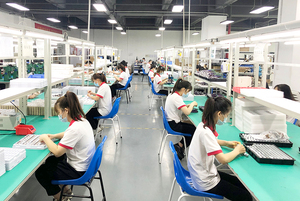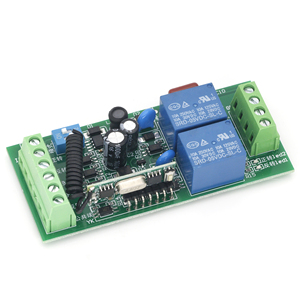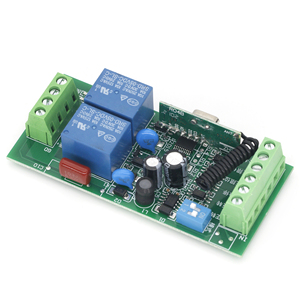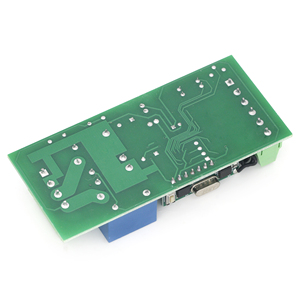
All categories
Featured selections
Trade Assurance
Buyer Central
Help Center
Get the app
Become a supplier

(151 products available)













































A DC motor forward reverse circuit is meant to allow both forward and reverse motion.
Brushed DC Motors
Brushed DC motors are the most commonly used DC motors. They are simple, cost-effective, and easy to control. These motors have brushes that provide contact between the rotating part, called the rotor, and a stationary part, the commutator, which provides power to the rotor through direct electrical connections. The rotor includes an electromagnet or winding that gets power from the commutator connected to the motor shaft. The magnetic field generated by the rotor interacts with the stator's magnetic field, causing the rotor and attached shaft to spin and produce motion. The brushes, made of carbon or graphite, slide on the commutator sections, providing power and allowing the motor to rotate. Brushed DC motors require periodic maintenance to replace worn-out brushes, but their low initial cost and ease of use make them popular in various applications. These applications include appliances, automotive power windows, and small machines.
Brushless DC Motors
Brushless DC motors replace the rotating electromagnet with a permanent magnet mounted on the motor shaft. An external power source or controller called an inverter, activates the motor by turning the electromagnet, known as the stator, while the permanent magnet is attached to the rotor or motor shaft that produces motion. The inverter continuously changes and delivers power to the motor, reducing the energy used. Controller not only consumes but also generates energy and vice versa. Brushless DC motors have high efficiency with low power consumption, such as electric vehicles, drones, and computer cooling fans.
Stepsper Motors
Stepper motors convert each electrical pulse sent to the motor into a fixed rotation or mechanical step. These motors rotate part or full steps, each corresponding to a specific angle. The motor is a coil, or electromagnet, with a unique permanent magnet rotor. energizing one coil causes the rotor to align with its magnetic field. energizing the next coil moves the rotor toward the next step. Steppers are efficient synchonous motor that is cheap and widely used in printers, and computer peripherals.
Servo Motors
AC & DC servo motors are used in or closed loop systems. It means that in these systems feedback is always available. Feedback refers to the replicating or referencing of previous information to enable a smooth automation process. Servo motors are either DC or AC. DC servo motors are continuous motis. DC servo motors are continuous motor sources. DC servo motors gain stability by continuously working within the error bound. These kinds of motors are used in any kind of dynamic control system.
Automotive Applications
DC motors are widely used in automobiles to drive different features. Smaller DC motors perform power windows opening and closing by power windows switch button. DC motors also used to power seats to adjust their positions and enhance users comfort. In higher end vehicles with automatic rear view mirrors, a small dc motor is used to move the mirror in response to the temperature sensor. Another important application of DC motor in the automobile industry is using it in electric vehicles to convert direct current to alternating current with the help of an inverter. In these applications, DC motors perform important functions and help to enhance features, comfort, and safety of the vehicle.
Consumer Electronics
DC motors are found in lots of consumer electronics such as vacuums, hair driers, electric shavers, and electric tooth brushes. In these appliances, the motors help to rotate brushes, fan blades, and other moving parts that perform the equipment functions. DC motors are preferred in consumers electronic appliances because they are compact, quiet, and can offer a range of speeds. This allows for fine control, making them suitable for tasks ranging from high power to delicate operations.
Industrial Machinery
DC motors are fundamental components of industrial machinery. They drive the conveyor belts, pumps, fans, and compressors and ensure the smooth running of these industries. The variable speed and high torque characteristics of DC motors are particularly useful for machinery that needs to operate at various speed levels depending on the production requirements. For instance, conveyor belt speed may have to be adjusted depending on the kind of product or its package.
Robotics
DC motors are widely used in robotics to drive different movable robot parts. This includes joints, arms, wheels, and grippers. Small DC motors generally provide the rotation or linear motion needed for precise movements. In addition, they can be used with gear systems to enhance torque or reduce speed.
Aerospace
DC motors are majorly used to control and move the satellite dishes, antennas, and cameras in outer space. These motors offer high reliability and can function well under the fluctuating temperatures and pressures that exist in the outer space environment.
Key Components
A reversing switch is a key component of a DC motor forward and reverse circuit. The reversing switch allows the direction of the current through the motor to be changed, thus reversing the motor direction. Another key component is the power source. The power sources used are usually batteries of different voltages. There are also half H bridge MOSFETs that help control the motor speed and direction electronically using a pulse width modulation signal.
Operating Conditions
In most DC motor forward reverse circuits, a voltage range of between 6V to 12V is usually employed. However, depending on the motor power and other factors, this voltage range can be wider. The circuit should be capable of sustaining continuous operation with a load that is meant to be typical for the intended application of the motor. DC motor forward and reverse circuits are generally meant to withstand typical environmental conditions while being resilient to dust, moisture, and extreme temperatures.
Maintenance Requirements
Regular inspection of all components, including the motor, power source, and reversing switch, is necessary for optimal performance. For components with brushes, such as in brushed DC motors, the brushes may need to be replaced after a certain period. There may also be a need to lubricate the motor to reduce friction and enhance the movements.
Certifications
DC motor forward reverse circuits commonly have certifications that include CE, RoHS, and ISO. For most consumer electronic products, certifications like CE and RoHS are required. For industries like automotive and aerospace, ISO certification may be needed.
Safety Features
Common safety features in these circuits include fuse or circuit breaker, which are meant to prevent overload or short circuit occurrences. There is also speed control, which helps prevent the motor from going beyond its maximum intended speed and causing possible damage.
A DC motor forward reverse circuit can be correctly installed in different ways depending on the application.
Wiring the Motor
The first step of the installation process is usually connecting the motor to the circuit. The power cables from the circuit are connected to the motor terminals. After this, the motor is connected to the reversing switch, which will be responsible for changing the current directed to the motor.
Power Source Connection
The power source is then connected to the circuit after connecting the motor. This power source is usually a battery. After connecting the battery, the circuit is then powered. The controlling elements are then connected next. If there are controlling elements like a speed controller or PWM, they should be connected next. This will allow the circuit to enable PWM speed control.
Mounting the Components
The components are then mounted after the connections have been made. To ensure this, the motor, switch, and any other components should be mounted on a stable surface to reduce accidents. Enclosures are also available for providing extra safety to the components.
Testing
To ensure that the components have been correctly connected, a tester should be run. The multimeter is used to ensure the circuit is live and check that all components are connected correctly. The motor should also be connected to a load that is typical for the new circuit. The testing phase comes to an end by powering the circuit and observing the motor behavior. The motor should rotate smoothly in one direction upon switching the switch, and it should also rotate smoothly in the opposite direction after changing the switch.
Regular Inspection
Inspections should be performed often to discover possible issues before they worsen. Look for sounds that are abnormal, shakes, and heat increase. Check all the components, including the motor, power source, and wiring, and replace the damaged ones immediately.
Cleaning
It should be ensured that the area around the circuit is always kept clean. Any debris, dust, or substance that can obstruct the functioning of the motor should be removed immediately. Occasional cleaning using a dry cloth of the components, especially the motor, will help in enhancing its performance.
Lubrication
The motor bearings and other movable parts should be lubricated frequently to reduce friction and ensure smooth movements. It should be ensured that the lubricant used is the right one. Do not use excess amount as it will attract more dust and dirt.
Brushes Replacement
For circuits that have a brushed DC motor, the brushes should be replaced often as required by the manufacturer. During the replacement of the brushes, it should also be ensured that the new ones used are original manufacturer's equipment(OEM).
Wiring Inspection
Check all the wires for signs of wear, corrosion, or damage, as damaged wires will affect the motor performance. Disconnect each wire carefully and use a multimeter to test it for continuity. Replace any wire that is damaged or worn out.
Battery Maintenance
If a battery is the power source, it should be maintained by cleaning its terminals and checking charge levels. Always ensure to use the right kind of battery for the circuit.
Quality Components
Using quality components like brushes, controllers, and batteries ensures long-lasting stability in the performance. Low quality components can result in time lags in motor response, more heat generation, and even failure of the parts. This not only reduces safety but causes hazardous events and losses.
Heat Dissipation
DC motors can get hot after a long usage period. DC motor forward and reverse circuits should be installed in an area that has good airflow. In areas where there is a high tendency for circuits to overheat, cooling fans have to be used in those areas. Overheating not only reduces efficiency, but in some cases it damages the components, causing safety risks.
Fuse
Internal or external fuses are very important in DC motor forward and reverse circuits. Only the fuses that are meant for the specific amperage range of the circuit should be used, and they should also not be overloaded. The circuit should ensure that it powers down when there is an occurrence of short or overcurrent so as to prevent possible harm.
Load Monitoring
Excessive loads on the motor can cause it to draw more currents than what is intended and eventually shorten its life. More worst-case scenarios may include blowing a fuse or burning the motor. Users have to ensure that the motor is always operating under its intended load capacity.
Water and Dust Resistance
If the DC motor forward and reverse circuit operates in a harsh environment with exposure to dust and water, one has to pay close attention to the quality and those that meet IP protection standards. DC motors and circuits that are resistant to dust and water will have a longer lifespan and work efficiently with fewer interruptions, hence more safety to the workers.
Periodic Maintenance
Regular maintenance helps discover possible problems before they worsen and cause safety issues. Maintenance involves checking for abnormal sounds, shaking, and observations of generated heat. It's also important to check all the components, including the motor, power source, and wiring, and replace the damaged ones.
Proper Storage
Apart from ensuring quality components, how the components are stored when not in use affects their quality. The circuit's components should be stored in a dry area with a moderate temperature. Exposure to humidity and extreme heat can destroy wires and batteries, affect the circuit performance, and more importantly, pose safety risks.
The motor, power source, and wiring are the components that have to be frequently maintained in a DC motor forward and reverse circuit. Regular maintenance helps prevent possible breakdowns and the reduced effectiveness of these components, which can cause safety issues.
Common certifications for a DC motor forward and reverse circuits include CE, ROHS, and ISO. For most consumer electronic products, certifications like CE and RoHS are required. For more industrial problems like automotive and aerospace, ISO certifications might be needed.
Yes, heat-related issues are common with DC motors, particularly with long use. One has to ensure that the area where DC motor forward and reverse circuits are located have good airflow. In areas with a high tendency for circuits to overheat, cooling fans must be used.
Regular inspections and using quality components increase the lifespan of components in a DC motor forward and reverse circuit. Maintenance is as simple as frequently checking for wear and tearing and replacing damaged parts.
Yes, excessive load on the motor can cause it to draw more currents than what is intended and eventually shorten its life. More worse case scenarios may include blowing a fuse or burning the motor. What is more, overload reduces efficiency, and safety hazards are created.